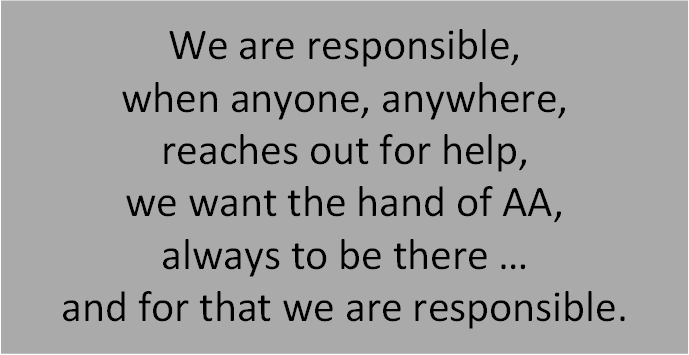As young people in A.A. have pointed out, alcoholism is not an age; it’s a disease. But just as young A.A.s have problems unique to their time of life, so do the elderly.
Most older A.A.s want to participate actively at meetings, but often the process of aging sickness, increasing frailty, reduced means, less mobility and independence proves to be overwhelming and, bit by bit, they quietly drop out.
“There is a lot of alcoholism among the aging,” says Rick D., C.P.C. chairperson, So. California Area Assembly. “It’s not just the active, long-time alcoholics we’re talking about; it’s the A.A.s who have been sober for years at one end of the spectrum and the people with a relatively short drinking history at the other. Despair is at the base. Maybe they have lost one loved one too many; they feel alone and vulnerable. They get into alcohol and drugs and depression. It’s the ’waiting to die’ syndrome and it’s all too prevalent.”
In his area, Rick reports, “the C.P.C. committee is expanding its established A.A. Contact Program, which provides temporary sponsorship for persons released from hospitals and treatment centers, to include those referred by employee assistance programs and senior citizen facilities and professionals gerontologists, social workers and counselors.”
To establish contact with the professionals, the C.P.C. committee has formed presentation groups. “Our people go directly into senior recreational centers, nursing homes and retirement facilities,” says Rick, “and distribute the A.A. contact card to people who may want to come to the Fellowship but are foggy about how to get here. The card is a small fold over that fits into a shirt pocket. It tells what A.A. can and cannot do, and gives the ’contact’ phone number. Once the alcoholic has our number, he or she has a place to begin. The phone is hooked up to an answering machine that is monitored closely. Although the program is fairly new, we’re beginning to get some calls from the older people.”
The A.A. Contact Program is made possible by support reaching back to the group level. At meetings, G.S.R.s ask for volunteers to act as sponsors – preferably members familiar with the Twelve Traditions. Hospitals and Institutions committee members, operating in panels of four or five A.A.s, carry word of the program to facilities all over Southern California. The Hll,I committees coordinate their outreach program with both the G.S.O. and the Los Angeles Central Service offices.
“Such was not always the case,” notes Rick. “For some time, efforts to coordinate the contact work of these services were splintered at best. Now, thanks largely to Ann G. (Panel 35 delegate), there’s been a major breakthrough in finding and achieving ways to work together effectively. And it’s getting better all the time.”
The Southern California C.P.C. is not alone in reach reaching out to the aging alcoholic. In New York, members of the Bronx Intergroup Institutions Committee, after overcoming some initial skepticism expressed by the staff, have been taking one weekly meeting, chaired by Ulyssice W., into a local nursing home, and are in the process of trying to introduce a second. The committee’s experience underscores the importance of establishing ongoing communication with senior citizen facilities – to help them understand how A.A. can serve as a lifeline to the aging alcoholic.
From the Washington, D.C. Area, C.P.C. chairperson Gerry G. reports that what started out as a questionnaire to determine group services needed for the deaf has expanded into a vehicle for learning what facilities are available for disabled persons in general, including the aged. Mailed initially to 300 groups, the questionnaire asks for such information as: How many steps must you climb to get to the meeting?. . . Are there restroom facilities available on the same floor as the meeting? . . . Do you have off-street parking?. . . and Does your group have smokers’ and nonsmokers’ meetings?
Thus far, approximately 60 groups have responded, Gerry says, and “the canvassing and compiling continue as an ongoing procedure. The information received is being transferred to 3×5 cards, filed by zip code and made available to intergroup desk workers.” Armed with this knowledge, he points out, they can better steer the handicapped and aged to meetings appropriate to their physical conditions.
In San Jose, California, oldtimer Dave W. has found a way to surmount the problems of bringing A.A. and older people together. “I’ve started a Long Timers Group which meets every week in the home of a woman who is sick and can’t get out,” he writes. “At our last meeting, we had nine A.A.s (sober 26 to 37 years) and three Al-Anon oldtimers. Of these, only four drive, including one Al-Anon whose husband is blind, so we’ve arranged transportation.” The members’ ages vary, he explains, as does their physical health. All have done much service and Twelve-Step work. One reason the meetings are so popular, he adds, “is the opportunity they provide for socializing. Loneliness is a big problem that aging A.A.s face.”
Some time ago, in the San Jose area newsletter, Good News, an 82-year-old A.A. sober 29 years shared her thoughts on problems of the aging in the Fellowship:
- If an older person is financially able to own a car, it still might be difficult for him or her to drive at night.It would be nice if someone would call and offer a ride to the meeting.
- Sometimes younger people are so busy with their own affairs that they unintentionally leave the older ones out of their sharing before and after meetings. There have been times I’ve wanted to quit going because I felt so left out.
- To the older A.A. member, it seems that the topics are getting far away from A.A. principles. We older people have emotional problems too, but they’re just a little different from those of the young ones. Our need to share never ends, so maybe the answer is “golden years” or “over-62” groups.
Many older A.A. members adjust creatively to the changes and losses that occur as part of the aging experience.
From Manson, Iowa, Marion B. writes: “I have emphysema and for over a year have had to give up my meetings because of smoke-filled rooms and steps to climb. I was about to give up everything. But, thanks to the grace of God and L.I.M. (Loners-Internationalists Meeting), I have more meetings now than before through the LI lvi. newsletter and letters from around the world. As it is said, when in trouble, ask for help.”
From another L.I.M.member, 80-year-old Lily P. of Albuquerque, New Mexico – known to some of her friends as “Caracas Lil” – comes an expression of gratitude: “It has been a long time, but I haven’t forgotten my L.I.M. friends. I’ve been dangerously ill with heart failure and all sorts of other medical problems, but I’m home from the hospital now and diligently trying to get better. Thank God for small mercies. I’m alive and still can think and hold a pen, although it takes the longest time to write the shortest letter.”
Loner George M., of Lakewood, Ohio, writes: “I haven’t had much motivation in my solitary, deaf, silent life. Yet I am so grateful for A.A. and the Lord’s having given me 29 years of sobriety.”
Thousands of older A.A.s have a wealth of experience in living sober to share. In turn, they may need the hand of A.A. to be there for them and provide some of the strength that younger bodies take for granted.
Like A.A.s everywhere, Betsy M. of Chicago goes out of her way to help elderly members on a one-to-one basis. “The way I look at it,” she says, “is that I’m 43 now. If I live to be old and infirm, I’ll need the support of A.A. more than ever. The’ Twelfth-Step work I do now is really a deposit toward my own future.”
As published in
News and Notes from the General Service Office of A.A. ® Box 459 Vol. 31, No. 2 – April/May 1986



